By Prabin Kalita
Guwahati, Aug 25 : Assam, which existed as the composite Assam Province under British rule, and the four new states carved out of it post Independence, are yet to come to terms with their demarcated boundaries.
The result — bloody border clashes.
Barring the two princely states of Tripura and Manipur, which were not annexed to Assam by the British, the four new states of Meghalaya, Arunachal Pradesh, Nagaland and Mizoram all have interstate border disputes with Assam.
The clashes along the Assam-Nagaland border, which broke out in Uriamghat in Golaghat district on August 12, spread to interior areas of Assam, resulting in a major law and order problem. At least 14 Assamese villagers were shot dead by armed Nagas and their houses burnt. Protesters in Assam directed their ire against the state government and accused it of failing to protect the border from the Nagas.
What followed were week-long clashes between protesters and Assam Police in Golaghat district till the Army was called in on Wednesday. Three agitators were killed when police opened fire to quell the protests.
For Assam chief minister Tarun Gogoi, the recent border trouble has been the most serious crisis he has faced since taking charge in 2001. People and his political rivals hold him responsible for giving Naga attackers a free run along the border.
Gogoi told TOI, "The border disputes started after the states were formed. We moved the Supreme Court to end the dispute with Nagaland and Arunachal Pradesh. Several border commissions have been set up to settle the issue with Nagaland, Arunachal and Meghalaya, but the other states have not accepted the recommendations of these panels. We are waiting for the Supreme Court's verdict because these commissions can only provide recommendations. They cannot ensure that they are binding."
Nagaland was the first to be carved out of Assam in 1963, followed by Meghalaya in 1972. This was followed by the creation of Mizoram as a union territory in 1972 (it became a state in 1986). Arunachal Pradesh, formerly known as North East Frontier Agency (NEFA) and annexed to Assam, attained union territory status in 1972 before becoming a full-fledged state in 1987.
Gogoi said, "Assam accepts the constitutional boundary defined at the time of creation of these states. But they (Mizoram, Meghalaya, Nagaland and Arunachal Pradesh) say they will accept only historical boundaries, instead of constitutional ones." By historical boundaries, these states mean boundaries which existed long before the country's Independence.
A government official said Nagaland is the biggest troublemaker along the border. The flashpoint of the Assam-Nagaland border conflict has always been Merapani in Golaghat district. In 1979, Nagas killed at least 70 Assamese villagers and Nagaland Police were alleged to have lent a helping hand. In 1985, another violent clash between the police forces of both states left 50 dead and several wounded. Many casualties were from Assam Police.
Minor clashes have been reported from the Assam-Mizoram border. Only the borders with Manipur and Tripura have been relatively peaceful so far.
Assam government records say that Nagaland has encroached upon 19,819.619 hectares of Assam's land, while Arunachal has captured 5,756.02 hectares and Meghalaya, 65.62 hectares, since 2001.
It is not just Meghalaya, Mizoram, Nagaland or Arunachal who have rejected the suggestions of the border commissions. Assam recently rejected recommendations by mediators appointed by the Supreme Court.
Nagaland and Manipur have locked horns over administrative control of Dzuko Valley, spread over Senapati district in Manipur and Kohima in Nagaland. Travel brochures of tourism departments of both states lay claim to the valley, known for its flowers.
Guwahati, Aug 25 : Assam, which existed as the composite Assam Province under British rule, and the four new states carved out of it post Independence, are yet to come to terms with their demarcated boundaries.
The result — bloody border clashes.
Barring the two princely states of Tripura and Manipur, which were not annexed to Assam by the British, the four new states of Meghalaya, Arunachal Pradesh, Nagaland and Mizoram all have interstate border disputes with Assam.
The clashes along the Assam-Nagaland border, which broke out in Uriamghat in Golaghat district on August 12, spread to interior areas of Assam, resulting in a major law and order problem. At least 14 Assamese villagers were shot dead by armed Nagas and their houses burnt. Protesters in Assam directed their ire against the state government and accused it of failing to protect the border from the Nagas.
What followed were week-long clashes between protesters and Assam Police in Golaghat district till the Army was called in on Wednesday. Three agitators were killed when police opened fire to quell the protests.
For Assam chief minister Tarun Gogoi, the recent border trouble has been the most serious crisis he has faced since taking charge in 2001. People and his political rivals hold him responsible for giving Naga attackers a free run along the border.
Gogoi told TOI, "The border disputes started after the states were formed. We moved the Supreme Court to end the dispute with Nagaland and Arunachal Pradesh. Several border commissions have been set up to settle the issue with Nagaland, Arunachal and Meghalaya, but the other states have not accepted the recommendations of these panels. We are waiting for the Supreme Court's verdict because these commissions can only provide recommendations. They cannot ensure that they are binding."
Nagaland was the first to be carved out of Assam in 1963, followed by Meghalaya in 1972. This was followed by the creation of Mizoram as a union territory in 1972 (it became a state in 1986). Arunachal Pradesh, formerly known as North East Frontier Agency (NEFA) and annexed to Assam, attained union territory status in 1972 before becoming a full-fledged state in 1987.
Gogoi said, "Assam accepts the constitutional boundary defined at the time of creation of these states. But they (Mizoram, Meghalaya, Nagaland and Arunachal Pradesh) say they will accept only historical boundaries, instead of constitutional ones." By historical boundaries, these states mean boundaries which existed long before the country's Independence.
A government official said Nagaland is the biggest troublemaker along the border. The flashpoint of the Assam-Nagaland border conflict has always been Merapani in Golaghat district. In 1979, Nagas killed at least 70 Assamese villagers and Nagaland Police were alleged to have lent a helping hand. In 1985, another violent clash between the police forces of both states left 50 dead and several wounded. Many casualties were from Assam Police.
Minor clashes have been reported from the Assam-Mizoram border. Only the borders with Manipur and Tripura have been relatively peaceful so far.
Assam government records say that Nagaland has encroached upon 19,819.619 hectares of Assam's land, while Arunachal has captured 5,756.02 hectares and Meghalaya, 65.62 hectares, since 2001.
It is not just Meghalaya, Mizoram, Nagaland or Arunachal who have rejected the suggestions of the border commissions. Assam recently rejected recommendations by mediators appointed by the Supreme Court.
Nagaland and Manipur have locked horns over administrative control of Dzuko Valley, spread over Senapati district in Manipur and Kohima in Nagaland. Travel brochures of tourism departments of both states lay claim to the valley, known for its flowers.









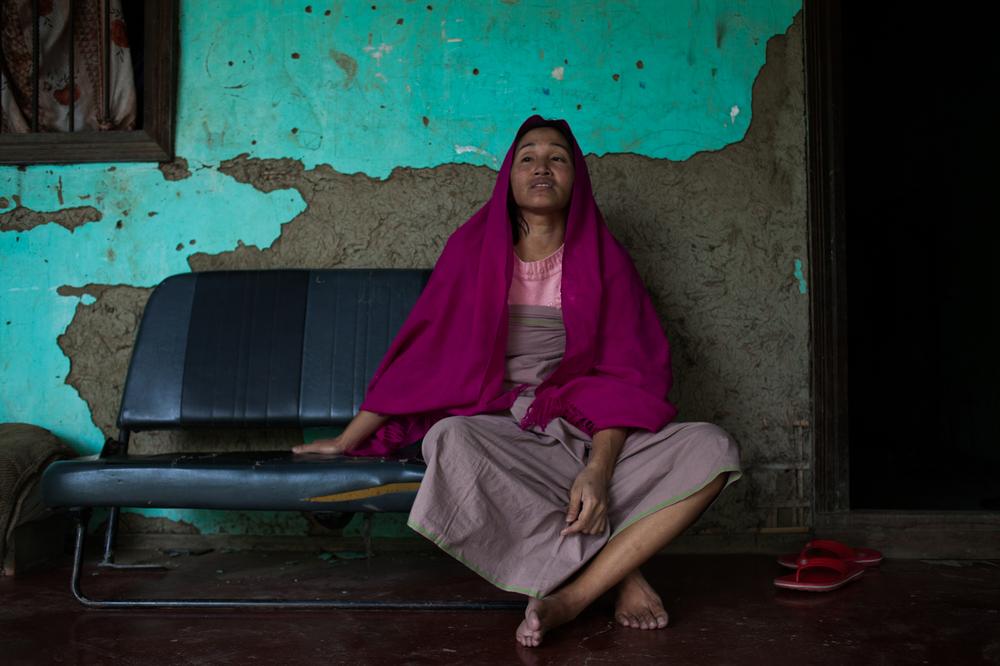 Gangarani
Kongkhang, 38, is a visually-impaired woman whose husband Deban
Kongkhang was killed after a hail of bullets were fired into the van he
was driving, allegedly by the Thoubal District Police Commandos at
Patpan Lamkhai in Imphal. The government vowed to punish the
perpetrators. She was promised a government job and financial
compensation but six years later she has received nothing. She lives on
handouts and takes care of her two children aged seven and 12.
Gangarani
Kongkhang, 38, is a visually-impaired woman whose husband Deban
Kongkhang was killed after a hail of bullets were fired into the van he
was driving, allegedly by the Thoubal District Police Commandos at
Patpan Lamkhai in Imphal. The government vowed to punish the
perpetrators. She was promised a government job and financial
compensation but six years later she has received nothing. She lives on
handouts and takes care of her two children aged seven and 12.
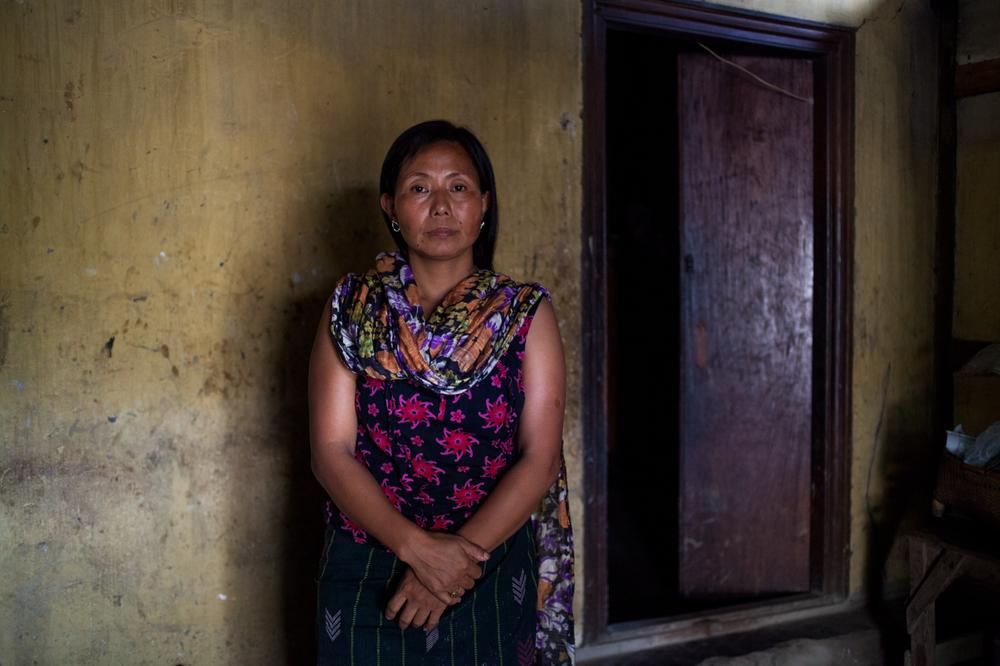 Wangkhem
Chandrakala's husband, Namoijan Lukhoi, was shot by two unidentified
men outside their home on April 21, 2008. She filed a police complaint
but gave up the case because she feared repercussions and worries about
the safety of her four school-going children. "Soon after my husband's
death, I went into depression and began to lose my senses. I would
wander off and find myself in the fields or in the crematorium. My
family members and neighbours had to keep an eye on me," she told Al
Jazeera.
Wangkhem
Chandrakala's husband, Namoijan Lukhoi, was shot by two unidentified
men outside their home on April 21, 2008. She filed a police complaint
but gave up the case because she feared repercussions and worries about
the safety of her four school-going children. "Soon after my husband's
death, I went into depression and began to lose my senses. I would
wander off and find myself in the fields or in the crematorium. My
family members and neighbours had to keep an eye on me," she told Al
Jazeera.
 Irom
Sharmila Chanu, known as "The Iron Lady of Manipur" has been on a
protest fast for last 14 years demanding the repeal of the Armed Forces
Special Powers Act. Here she is pictured in her Security Ward at the
Jawaharlal Nehru Institute of Medical Sciences in Imphal. She was
released on Wednesday.
Irom
Sharmila Chanu, known as "The Iron Lady of Manipur" has been on a
protest fast for last 14 years demanding the repeal of the Armed Forces
Special Powers Act. Here she is pictured in her Security Ward at the
Jawaharlal Nehru Institute of Medical Sciences in Imphal. She was
released on Wednesday.
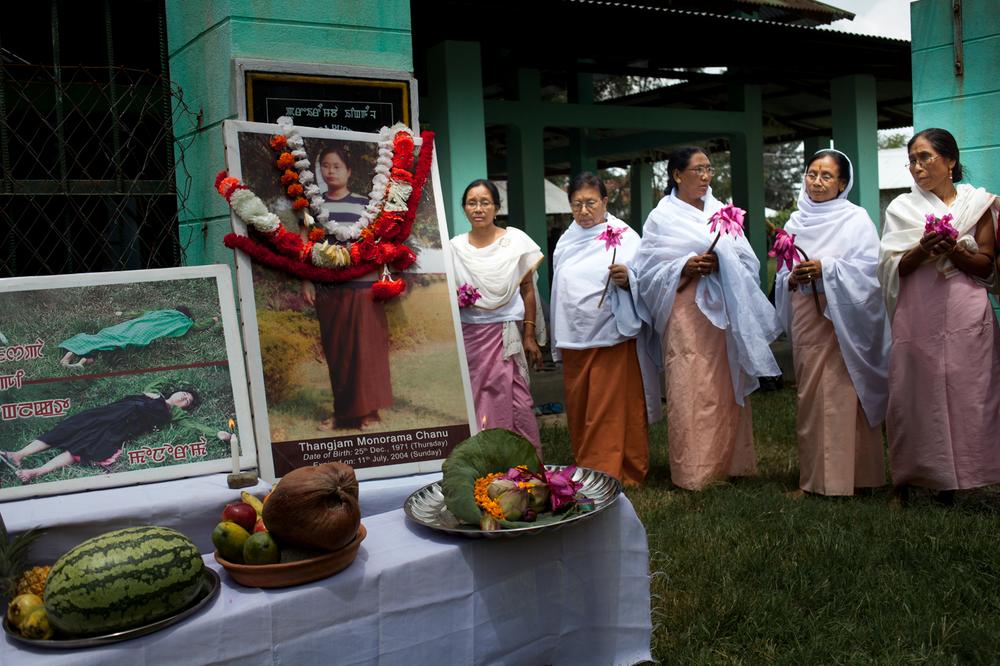 Family
members and local activists attend the memorial service held on the
tenth anniversary of Thangjam Manorama's death on July 10 at Bamon Kampu
Mayai Lekai in Imphal. Manorama was picked up on July 9, 2004 by the
17th Assam Rifles. She was found raped and murdered with bullet wounds
on her genitalia the next day near her home in Ngariyan Maring. Her
death sparked widespread protests in Manipur and other parts of India.
Family
members and local activists attend the memorial service held on the
tenth anniversary of Thangjam Manorama's death on July 10 at Bamon Kampu
Mayai Lekai in Imphal. Manorama was picked up on July 9, 2004 by the
17th Assam Rifles. She was found raped and murdered with bullet wounds
on her genitalia the next day near her home in Ngariyan Maring. Her
death sparked widespread protests in Manipur and other parts of India.
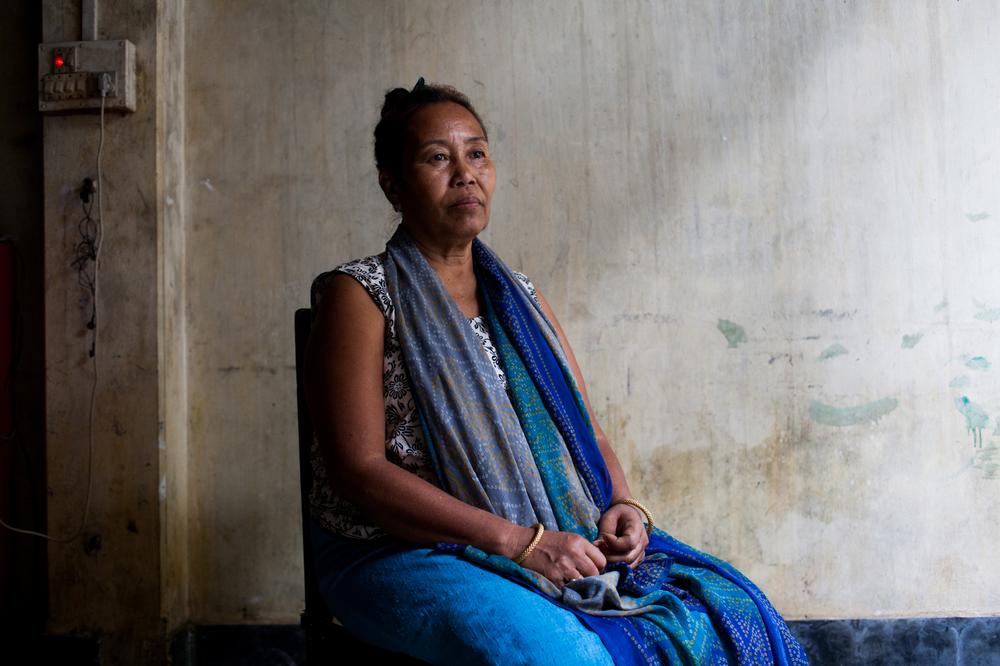 Khumbongmayum
Lata Devi's 20-year-old son Khumbongmayum Orsonjit Singh was killed by
the Manipur Police Commandos on March 16, 2010. His is one of the cases
concluded to be a fake encounter by a commission appointed by the
Supreme Court.
Khumbongmayum
Lata Devi's 20-year-old son Khumbongmayum Orsonjit Singh was killed by
the Manipur Police Commandos on March 16, 2010. His is one of the cases
concluded to be a fake encounter by a commission appointed by the
Supreme Court.
 Irom
Sharmila waits in her ambulance on July 7 as armed guards stand by
outside the Appellate Court in Lamphel. She began her fast on November
2, 2000 when 10 civilians were killed at a bus stop by the Assam Rifles
in the Malom district near Imphal airport.
Irom
Sharmila waits in her ambulance on July 7 as armed guards stand by
outside the Appellate Court in Lamphel. She began her fast on November
2, 2000 when 10 civilians were killed at a bus stop by the Assam Rifles
in the Malom district near Imphal airport.
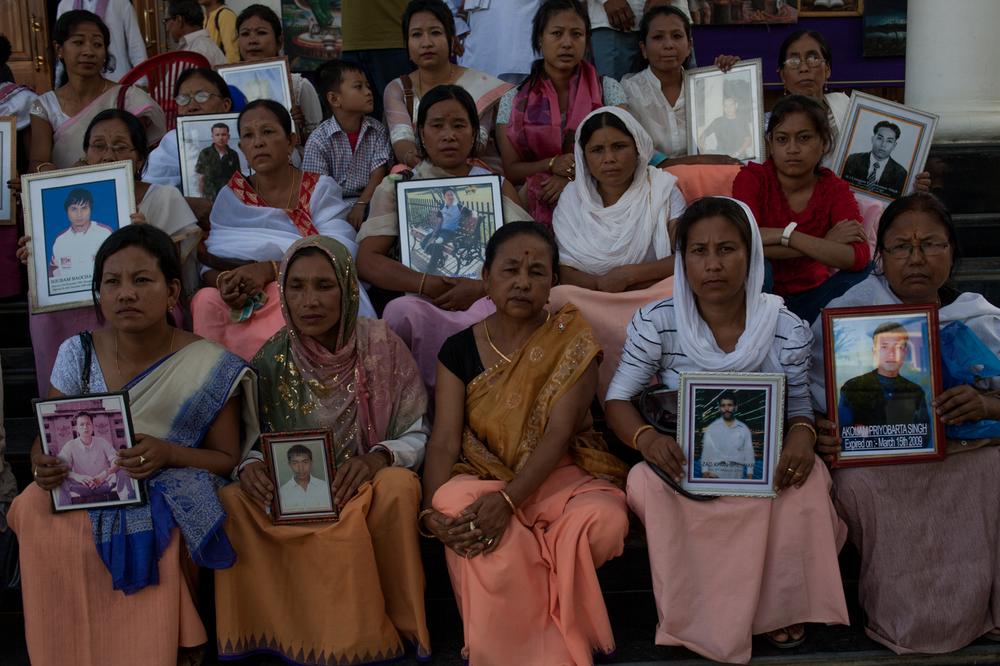 Women
who are part of the Extrajudicial Execution Victims Families
Association of Manipur (EEVFAM) pose for a photograph with portraits of
family members who were killed by armed forces on the fifth anniversary
of EEVFAM in Imphal. EEVFAM provides support and counsels families in
dealing with the loss of their husbands and sons and in dealing with the
stigma of their family members being labeled as underground rebels.
Women
who are part of the Extrajudicial Execution Victims Families
Association of Manipur (EEVFAM) pose for a photograph with portraits of
family members who were killed by armed forces on the fifth anniversary
of EEVFAM in Imphal. EEVFAM provides support and counsels families in
dealing with the loss of their husbands and sons and in dealing with the
stigma of their family members being labeled as underground rebels.
 On
January 24, 2009, Soraishem Joy, 40, was picked up from his home by
Assam Rifles soldiers and was blindfolded and beaten in an open field
and waterboarded at their camp in Patsoi, near Imphal. He was forced to
sign a blank piece of paper and was later thrown in jail for six days
after which he was released because villagers protested and pleaded his
innocence. "If it wasn't for my neighbours and family support, I would
have been a dead body like all those other fake encounter cases. I have
done nothing wrong," he says.
On
January 24, 2009, Soraishem Joy, 40, was picked up from his home by
Assam Rifles soldiers and was blindfolded and beaten in an open field
and waterboarded at their camp in Patsoi, near Imphal. He was forced to
sign a blank piece of paper and was later thrown in jail for six days
after which he was released because villagers protested and pleaded his
innocence. "If it wasn't for my neighbours and family support, I would
have been a dead body like all those other fake encounter cases. I have
done nothing wrong," he says.
 Flowers are placed in front of portraits of men who were victims of extrajudicial killings.
Flowers are placed in front of portraits of men who were victims of extrajudicial killings.
 RK
Surjalata Singh, 50, lost her 26-year-old son Irengbam Roshan on May 8,
2012. He was allegedly shot by the Assam Rifles in the Ukhrul district
in Manipur. Surjalata remembers her son's body at the morgue as having
burn marks from scalding water and bullet wounds suggesting torture
methods were used. Surjalata's younger brother, RK Khogen was also
killed in the 1995 RIMS (Regional Institute of Medical Sciences)
massacre in Imphal when security forces opened fire, killing nine
civilians.
RK
Surjalata Singh, 50, lost her 26-year-old son Irengbam Roshan on May 8,
2012. He was allegedly shot by the Assam Rifles in the Ukhrul district
in Manipur. Surjalata remembers her son's body at the morgue as having
burn marks from scalding water and bullet wounds suggesting torture
methods were used. Surjalata's younger brother, RK Khogen was also
killed in the 1995 RIMS (Regional Institute of Medical Sciences)
massacre in Imphal when security forces opened fire, killing nine
civilians.
 Neena
Ningombam, 33, lost her husband Michael Nongmaithem in 2008. Michael
was accused by the police of being a rebel and was allegedly shot for
trying to escape. After her husband's death, she joined other widows
whose husbands were killed by the Indian Army and started a campaign
against army atrocity. She has two sons, aged six and 12.
Neena
Ningombam, 33, lost her husband Michael Nongmaithem in 2008. Michael
was accused by the police of being a rebel and was allegedly shot for
trying to escape. After her husband's death, she joined other widows
whose husbands were killed by the Indian Army and started a campaign
against army atrocity. She has two sons, aged six and 12.
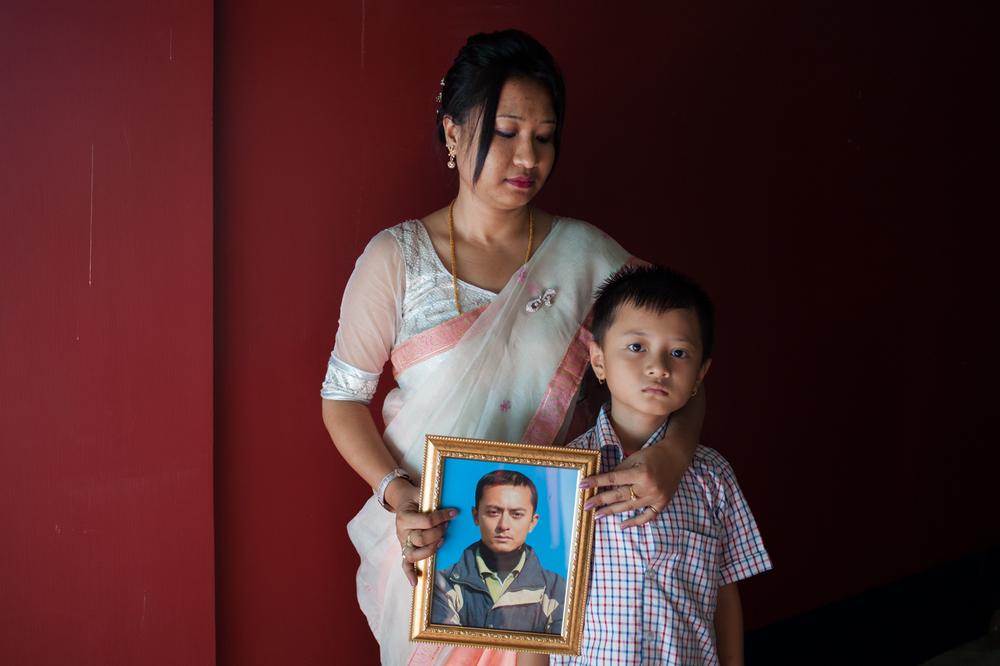 Roni,
30, with her nine-year-old son Mutum Mir. Her husband Mutum Herojit,
38, was killed in an encounter on October 13, 2008. "I want justice for
my husband. No other woman's husband should die in the future. I want to
tell the government that this killing should stop or else Manipur will
become a state of widows," she told Al Jazeera.
Roni,
30, with her nine-year-old son Mutum Mir. Her husband Mutum Herojit,
38, was killed in an encounter on October 13, 2008. "I want justice for
my husband. No other woman's husband should die in the future. I want to
tell the government that this killing should stop or else Manipur will
become a state of widows," she told Al Jazeera.



